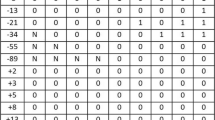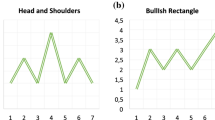Abstract
In this study, we propose a new framework to analyze the stock-specific mictrotrading patterns preceding stock price jumps, which should be useful for financial regulation or investment decisions. Using high-frequency trading data, the key step of our framework is to extract a set of core features to distinguish the prejump trading patterns of various stocks taking into account of the temporal information within the feature trajectories. We adopt 10 liquidity measures and 30 technical indicators to generate a high-dimensional candidate feature trajectory set and use a combination of the time-series-based mutual information and the minimum-Redundancy Maximum-Relevancy technique to perform the feature selection. A clustering analysis is then adopted to identify the outlier stocks with idiosyncratic prejump trading patterns. In the end, an application case is conducted based on the level-2 data of 189 constituent stocks of the China Security Index 300 to illustrate the viability of our proposed methodology. Comparison results show that the features we selected has higher capacity to identify the similarity among trading trajectories than those without considering temporal feature information, which provides more reliable features in detecting the outlier trading patterns.







Similar content being viewed by others
Data Availability
The data that support the findings of this study are provided by Shanghai Wind Information Co., Ltd. (http://www.wind.com.cn).
Code availability
The code is available upon request.
Notes
In Lee and Mykland (2008), the numerator of the second term of $C_n$ was incorrect. There should be \(\log(4 \pi)\) instead of \(\log\pi\). We use the corrected formula. It has also been noted in some studies, for example, in Gilder, Shackleton and Taylor (2014). We thank Ping-Chen Tsai for pointing out this issue.
References
Bȩdowska-Sójka, B. (2016). Liquidity dynamics around jumps: The evidence from the Warsaw stock exchange. Emerging Markets Finance and Trade, 52(12), 2740–2755.
Bȩdowska-Sójka, B., Kliber, A. (2021). Information content of liquidity and volatility measures. Physica A: Statistical Mechanics and its Applications, 563, 125436.
Berndt, D., Clifford, J. (1994). Using dynamic time warping to find patterns in times series. In AAAI-94 workshop on knowledge discovery in databases (pp. 359–370).
Bollerslev, T., & Todorov, V. (2011). Tails, fears, and risk premia. The Journal of Finance, 66(6), 2165–2211.
Boudt, K., & Pertitjean, M. (2014). Intraday liquidity dynamics and news releases around price jumps: Evidence from the DJIA stocks. Journal of Financial Markets, 17, 121–149.
Brennan, M. J., Huh, S. W., & Subrahmanyam, A. (2018). High-frequency measures of informed trading and corporate announcements. Review of Financial Studies, 31(6), 2326–2376.
Caporin, M., Kolokolov, A., & Renò, R. (2017). Systemic co-jumps. Journal of Financial Economics, 126(3), 563–591.
Chen, Y. T., Lai, W. N., & Sun, E. W. (2019). Jump detection and noise separation by a singular wavelet method for predictive analytics of high-frequency data. Computational Economics, 54(2), 809–844.
Das, A. K., Sengupta, S., & Bhattacharyya, S. (2018). A group incremental feature selection for classification using rough set theory based genetic algorithm. Applied Soft Computing, 65(65), 400–411.
Dobrushin, R. L. (1958). A simplified method of experimentally evaluating the entropy of a stationary sequence. Theory of Probability & Its Applications, 3(4), 428–430.
Duffie, D., & Pan, J. (2001). Analytical value-at-risk with jumps and credit risk. Finance and Stochastics, 5(6), 155–180.
Fang, L., Zhao, H., Wang, P., Yu, M., Yan, J., Cheng, W., & Chen, P. (2015). Feature selection method based on mutual information and class separability for dimension reduction in multidimensional time series for clinical data. Biomedical Signal Processing and Control, 21, 82–89.
Gao, Y., Han, X., Li, Y., & Xiong, X. (2019). Overnight momentum, informational shocks, and late informed trading in China. International Review of Financial Analysis, 66, 101394.
Gonzalez-Lopez, J., Ventura, S., & Cano, A. (2020). Distributed multi-label feature selection using individual mutual information measures. Knowledge-Based Systems, 188, 105052.
Groth, S. S., Siering, M., & Gomber, P. (2014). How to enable automated trading engines to cope with news-related liquidity shocks? Extracting signals from unstructured data. Decision Support Systems, 62, 32–42.
Han, M., Ren, W., & Liu, X. (2015). Joint mutual information-based input variable selection for multivariate time series modeling. Engineering Applications of Artificial Intelligence, 37, 250–257.
He, G., Zhao, W., Xia, X., Peng, R., & Wu, X. (2019). An ensemble of shapelet-based classifiers on inter-class and intra-class imbalanced multivariate time series at the early stage. Soft Computing, 23(15), 6097–6114.
Ircio, J., Lojo, A., Mori, U., & Lozano, J. A. (2020). Mutual information based feature subset selection in multivariate time series classification. Pattern Recognition, 108, 107525.
Jang, J., & Kang, J. (2019). Probability of price crashes, rational speculative bubbles, and the cross-section of stock returns. Journal of Financial Economics, 132(1), 222–247.
Jarrow, R., & Rosenfeld, E. (1984). Jump risks and the intertemporal capital asset pricing model. Journal of Business, 57(3), 337–351.
Jiang, G. J., Lo, I., & Verdelhan, A. (2011). Information shocks, liquidity shocks, jumps, and price discovery: Evidence from the U.S. treasury market. Journal of Financial and Quantitative Analysis, 46(2), 527–551.
Joulin A, Lefevre A, Grunberg D, Bouchaud JP (2008) Stock price jumps: news and volume play a minor role. arXiv:0803.1769v1
Jovic, A., & Jovic, F. (2017). Classification of cardiac arrhythmias based on alphabet entropy of heart rate variability time series. Biomedical Signal Processing and Control, 31, 217–230.
Kapadia, N., & Zekhnini, M. (2019). Do idiosyncratic jumps matter? Journal of Financial Economics, 131(3), 666–692.
Kong, A., Zhu, H., & Azencott, R. (2021). Predicting intraday jumps in stock prices using liquidity measures and technical indicators. Journal of Forecasting, 40(3), 416–438.
Kozachenko, L. F., & Leonenko, N. N. (1987). Sample estimate of the entropy of a random vector. Problemy Peredachi Informatsii, 23(2), 9–16.
Kraskov, A., Stögbauer, H., & Grassberger, P. (2004). Estimating mutual information. Physical Review E-Statistical Physics, Plasmas, Fluids, and Related Interdisciplinary Topics, 69, 066138.
Lahaye, J., Laurent, S., & Neely, C. (2011). Jumps, Cojumps and Maro announcements. Journal of Applied Econometrics, 26(6), 893–921.
Lakhal, F. (2008). Stock market liquidity and information asymmetry around voluntary earnings disclosures New evidence from France. International Journal of Managerial Finance, 4(1), 60–75.
Lee, S. S., & Mykland, P. A. (2008). Jumps in financial markets: A new nonparametric test and jump dynamics. Review of Financial Studies, 21(6), 2535–2563.
Leong, C. K. (2016). Credit risk scoring with Bayesian network models. Computational Economics, 47(3), 423–446.
Li, S., Ning, K., & Zhang, T. (2021). Sentiment-aware jump forecasting. Knowledge-Based Systems, 228, 107292.
Liu, L., Patton, A. J., & Sheppard, K. (2015). Does anything beat 5-minute RV? A comparison of realized measures across multiple asset classes. Journal of Econometrics, 187(1), 293–311.
Mäkinen, M., Kanniainen, J., Gabbouj, M., & Iosifidis, A. (2019). Forecasting of jump arrivals in stock prices: New attention-based network architecture using limit order book data. Quantitative Finance, 19(12), 2033–2050.
Merton, R. (1976). Option pricing when underlying stock returns are discontinuous. Journal of Financial Economics, 3(1–2), 125–144.
Meyer, P. E., Schretter, C., & Bontempi, G. (2008). Information-theoretic feature selection in microarray data using variable complementarity. IEEE Journal of Selected Topics in Signal Processing, 2(3), 261–274.
Ni, X., Peng, Q., Yin, S., & Zhang, T. (2020). Attention! Distracted institutional investors and stock price crash. Journal of Corporate Finance, 64(64), 101701.
Podolskij, M., & Ziggel, D. (2010). New tests for jumps in semimartingale models. Statistical Inference for Stochastic Processes, 13(2), 15–41.
Prodromou, T., & Westerholm, P. J. (2022). Are high frequency traders responsible for extreme price movements? Economic Analysis and Policy, 73, 94–111.
Ranaldo, A. (2008). Intraday market dynamics around public information arrivals intraday market dynamics around public information arrivals. In S. Market, G. N. Gregoriou, & F. S. Lhabitant (Eds.), Implications for market microstructure and asset pricing, liquidity (pp. 199–226). Hoboken: Wiley.
Riordan, R., Storkenmaier, A., Wagener, M., & Zhang, S. S. (2013). Public information arrival: Price discovery and liquidity in electronic limit order markets. Journal of Banking and Finance, 37(4), 1148–1159.
Ross, B. C. (2014). Mutual information between discrete and continuous data sets. PLoS ONE, 9(2), e87357.
Saikhu, A., Arifin, A. Z., & Fatichah, C. (2019). Correlation and symmetrical uncertainty-based feature selection for multivariate time series classification. International Journal of Intelligent Engineering and Systems, 12(3), 129–137.
Shannon, C. E. (2001). A mathematical theory of communication. ACM SIGMOBILE Mobile Computing and Communication Review, 5(1), 3–55.
Song, X. F., Zhang, Y., Gong, D. W., Sun, X. Y. (2021). Feature selection using bare-bones particle swarm optimization with mutual information. Pattern Recognition, 112, 107804.
Steuer, R., Kurths, J., Daub, C. O., Weise, J., & Selbig, J. (2002). The mutual information: Detecting and evaluating dependencies between variables. Bioinformatics, 18(Suppl. 2), S231-240.
Su, Z., Bao, H., Li, Q., Xu, B., & Cui, X. (2022). The prediction of price gap anomaly in Chinese stock market: Evidence from the dependent functional logit model. Finance Research Letters, 47, 102702.
Sun, B., & Gao, Y. (2020). Market liquidity and macro announcement around intraday jumps: Evidence from Chinese stock index futures markets. Physica A: Statistical Mechanics and its Applications, 541, 123308.
Van Ness, B., Van Ness, R., & Yildiz, S. (2021). Private information in trades, R2, and large stock price movements. Journal of Banking and Finance, 131, 106194.
Vergara, J. R., & Estévez, P. A. (2014). A review of feature selection methods based on mutual information. Neural Computing and Applications, 24(1), 175–186.
Wan, D., Wei, X., & Yang, X. (2017). Liquidity dynamics around intraday price jumps in Chinese stock market. Journal of Systems Science and Complexity, 30(2), 434–463.
Wen, F., Xu, L., Ouyang, G., & Kou, G. (2019). Retail investor attention and stock price crash risk: Evidence from China. International Review of Financial Analysis, 65(65), 101376.
Xu, Y., Xuan, Y., & Zheng, G. (2021). Internet searching and stock price crash risk: Evidence from a quasi-natural experiment. Journal of Financial Economics, 141(1), 255–275.
Yoon, H., Yang, K., & Shahabi, C. (2005). Feature subset selection and feature ranking for multivariate time series. IEEE Transactions on Knowledge and Data Engineering, 17(9), 1186–1198.
Zhou, C., Wu, C., & Wang, Y. (2018). Dynamic portfolio allocation with time-varying jump risk. Journal of Empirical Finance, 50, 113–124.
Zhou, H., Wang, X., & Zhu, R. (2022). Feature selection based on mutual information with correlation coefficient. Applied Intelligence, 52(5), 5457–5474.
Zhu, Y., Wu, Z., Zhang, H., & Yu, J. (2017). Media sentiment, institutional investors and probability of stock price crash: Evidence from Chinese stock markets. Accounting and Finance, 57(5), 1635–1670.
Funding
This work was supported by China Postdoctoral Science Foundation (2021M701670), Jiangsu Planned Projects for Postdoctoral Research Funds (2021K357C), National Natural Science Foundation of China (71720107001, U1811462, 72071103, 72001104), Fundamental Research Funds for the Central Universities(0118/14370107),and Humanities and Social Science Fund of the Ministry of Education (17YJA790101).
Author information
Authors and Affiliations
Contributions
All authors contributed to the study conception and design. All authors read and approved the final manuscript.
Corresponding author
Ethics declarations
Conflict of interest
The authors declared that they have no conflict of interest to this work.
Additional information
Publisher's Note
Springer Nature remains neutral with regard to jurisdictional claims in published maps and institutional affiliations.
Rights and permissions
Springer Nature or its licensor (e.g. a society or other partner) holds exclusive rights to this article under a publishing agreement with the author(s) or other rightsholder(s); author self-archiving of the accepted manuscript version of this article is solely governed by the terms of such publishing agreement and applicable law.
About this article
Cite this article
Kong, A., Azencott, R., Zhu, H. et al. Pattern Recognition in Microtrading Behaviors Preceding Stock Price Jumps: A Study Based on Mutual Information for Multivariate Time Series. Comput Econ 63, 1401–1429 (2024). https://doi.org/10.1007/s10614-023-10367-6
Accepted:
Published:
Issue Date:
DOI: https://doi.org/10.1007/s10614-023-10367-6




